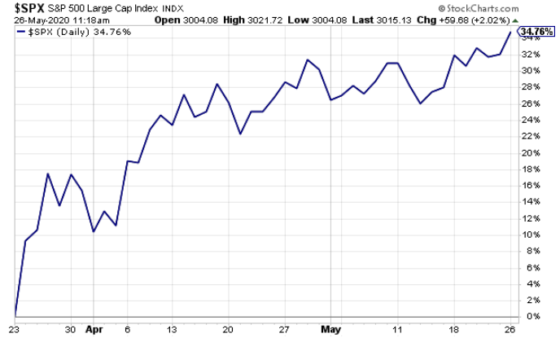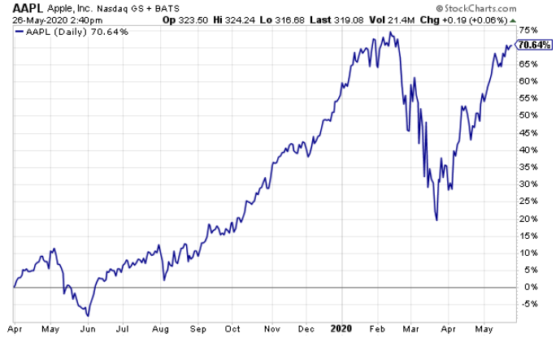“The Market” Isn’t the Same as “Stocks”
Can we trust this market rally … and why you really don’t have to. Investors should stay focused on stocks within the market, and not “the market” itself
Yesterday, prominent investor and economic advisor, Mohamed El-Erian said there’s “good news across the board.” The phrase filled headlines.
Of course, there were warnings in his follow-up comments, including “we should buckle our seatbelts” and “this is not going to be a smooth process.”
His back-and-forth comments reflect the tension of today’s market.
On one hand, there are valid reasons for concern …
An overextended rally, a hobbled economy, the stock market trading at its highest valuation in 18 years (on a forward PE basis), the threat of a coronavirus-resurgence in the fall, escalating tensions with China …
On the other hand, we have a stock market that appears simply unwilling to relent, shaking off jaw-dropping economic data as it stares off into the distance at “back to normal.”
In many ways it boils down to the ‘ole “immoveable object versus unstoppable force” dilemma …
In one corner, we have the Fed, with its “bazooka of liquidity” as well as its “infinite amount of cash” (according to Neel Kashkari, president of the Federal Reserve Bank of Minneapolis).
In the other corner, we have the utter economic destruction of the coronavirus — historic unemployment, skyrocketing debt, and a recession.
Who wins when these titans rumble?
Well, so far, the Fed is winning.
Below you can see the S&P blazing 35% higher since its late-March low.

But this can leave a conservative investor in a tough spot — invest now and risk having your money exposed to a potential selloff from any one of the red flags we highlighted above? Or continue to sit on the sidelines, risking missing out on a recovery that leaves your portfolio in the dust?
***Perhaps this is a faulty way of looking at the matter
It’s easy to reference “the S&P” and to talk in broad generalities about the economy. Unfortunately, far too many details get lost when we do this.
For example, discussing the S&P’s meteoric rally doesn’t reflect the decimation in the retail sector.
And highlighting the pain of, say, the airlines or the tourism industry means little to select tech-related companies that have seen their revenues surge under lockdown.
For investors, the real story is in the details.
Here’s how our CEO, Brian Hunt, recently described it:
Around the InvestorPlace offices, we often say, “It’s not so much a stock market as it is a market of stocks.”
We say this because the stock market is made up of many different industries and many different companies. Various economic climates affect industries differently. Something good for one industry isn’t necessarily good for another industry.
For example, the early stage of the coronavirus crisis was great for grocery stores because people rushed to stock up on food … but it was terrible for cruise line operators and airlines …
Instead of thinking of “the market” as a monolithic entity into which you put money, we prefer to focus our attention on individual industries and companies. There’s quite a lot happening behind the curtain we call the Dow Jones Industrials Average.
In a recent update to subscribers, famed growth investor, Louis Navellier, took this same idea and applied it to today’s market:
… I envision more of a stock-picking market moving forward, and less of just a pure sector market.
I’m a stock-picker — so I’m comfortable with that. The bottom line is, you should be prepared for an increasingly narrow market, with drastic differences between winners and losers.
So, first, for today, let’s stop conflating “the market” with how all stocks are doing. Let’s also apply the same measure to the economy versus its various subsets.
***But investors might embrace another change in thinking today to help navigate this complex market
It ties into the distinction between “cheapness” and “value.”
As mentioned at the top of this Digest, right now, the S&P is trading around its highest valuation level in nearly two decades. That’s according to its forward-looking price-to-earnings ratio. This ratio compares what investors are paying today, for what they believe will be a company’s earnings next year.
Data company, Factset, reports that the forward 12-month P/E ratio is 21.0. This puts it 39% more expensive than the average 12-month P/E ratio over the last 10 years (15.1).
Now, a traditional value investor would have no part of this market.
After all, the basic premise of value investing is to pick up great stocks only when they’re trading at significant discounts to their fair market value. And even the most diehard bullish investor today would probably have a hard time making the case that stocks are downright cheap.
But there are issues with “cheap” too.
As any value investor would admit, just because a stock is cheap doesn’t mean it’s about to surge higher. Cheap can stay cheap for many years. Worse, a cheap stock can often confound value investors by, well, getting cheaper.
Plus, if we invested purely from a valuation perspective, then there would be long stretches — months, even years — when valuations would remain too rich for new money to be invested, yet stocks soared regardless.
Take Apple …
Over the last five years, Apple’s average P/E ratio has been 16.3. That’s about the same as the average long-term P/E ratio for the S&P 500 (nearly 16).
So, if we decided to buy Apple only when it was trading below a P/E of 16, that means we wouldn’t have touched it anytime since April of last year.
Of course, here’s how much Apple’s stock has risen since then — including the losses it incurred in the coronavirus-selloff (it’s 71% if you’re reading on a mobile).

***This is a helpful reminder that what we want is a “big return” not just a “discounted entry price”
The assumption from value investors is that a discounted entry price will lead to a big return, but that’s not a sure bet.
Plus, where does it say that an overvalued stock has to fall?
Bottom line, would you prefer to invest in a stock with a nosebleed valuation that goes on to make you 50%, or a diamond-in-the-rough value stock that trades sideways and makes you 0%?
With this in mind, is there a tweak to “cheap” we can make?
Let’s return to Louis, this time from his update on Sunday:
… look for buys when a stock has become a bargain. And I don’t just mean “cheap”; I mean a good value.
In other words, look for a company that’s still growing like crazy — in terms of sales, operating margins, and especially earnings. Whenever its stock experiences a sell-off … then that’s a great opportunity. And those fundamental factors are exactly what I’ve designed my system to detect.
But, again, you only want the highest-quality companies.
In this light, buying something cheap is less important than buying something quality that’s surging. And in today’s market, despite the many causes for concern, there are plenty of quality, surging stocks.
Another good thing about adopting this approach is it’s equally helpful in terms of knowing when to sell a stock.
Back to Louis:
… you can shift the engine into reverse, too. When an investment starts to slip on these factors, it’s time to sell. (Especially when the crowd hasn’t caught on yet.)
In total, there’s 8 factors to look for. Apply them to the fastest-moving stocks around, and that’s the basis for my newest endeavor, The Accelerated Income Project.
Once you have these 8 precursors in mind, the results can be phenomenal.
To learn more about Louis’ approach, click here.
Bottom line, adopting a general perspective of “value” not just “cheapness” can help investors today who are struggling with how to respond to this complex market. The market isn’t trading at a discount, but that doesn’t mean there isn’t money to be made.
Have a good evening,
Jeff Remsburg